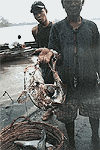 |
 |
Irrawady River Dolphins |
Story by Iola Veal Thongsa-ard
Photos by Piyawit Thongsa-ard |
|
 |
|
According to a traditional Cambodian fable, one of the ancient Cambodian King's wives, having drowned in the Irrawady River, was transformed into the world's first dolphin. It is no wonder then that among the Cambodians, as well as the Lao, communities strewn along the stretches of the Mekong, dolphins are considered reincarnations of their ancient ancestors. As a testament to the love, care, and respect the Cambodian and Lao villagers have for the Irrawady River dolphins, or the Pak-ha, the villagers relate stories of days long-gone when the waters of the Mekong teamed with the playful dolphins. Today, in the entire Mekong, there remain a mere 10 individual Irrawady River dolphins. |
 |
|
How did the dolphins go from being one of the most adored and abundant sea creatures in the Irrawady to one of the most endangered species in the world? The Khmer Rouge, bombings, illegal, disruptive, and uninformed fishing practices, and rapid population growth are among the most significant factors in the decline of the Irrawady River dolphin population. During their reign of terror, the Khmer Rouge reportedly shot 1,000 Irrawady River dolphins, to extract valuable oil for war machinery, and in an effort to crush local beliefs about the dolphins. Subsequent American aerial bombardment of the Sekong River sub-basin in the People's Democratic Republic of Laos is also believed to have taken a heavy toll on the dolphin and fish populations in the region. More recently, gill-nets, killing near everything that gets entangled within them, as well as illegal dynamite fishing, its prohibition too weakly enforced in both Laos and Cambodia, have caused the Irrawady River dolphin population to decline. A rapidly increasing demand for freshwater fish by both local and foreign markets (Thailand) has also played a significant part in the population decline.
|
 |
|
Since the Lao Fisheries Community and Dolphin Protection Project ceased to exist due to a lack of EU funding in early 1999, the fate of the Irrawady River dolphin continues to be bleak...
|
|